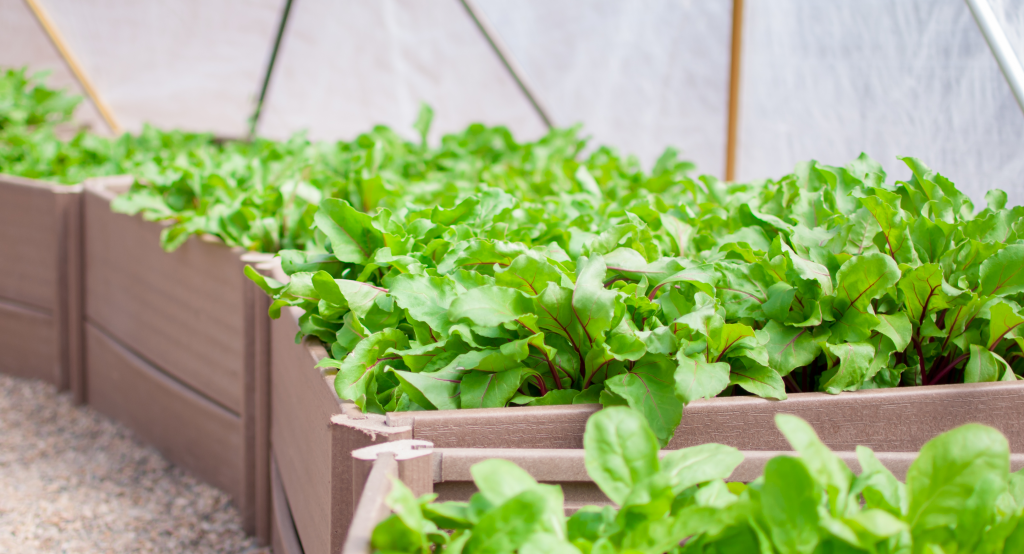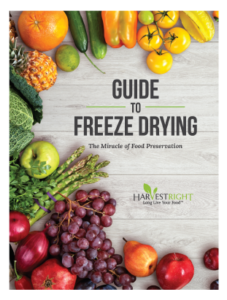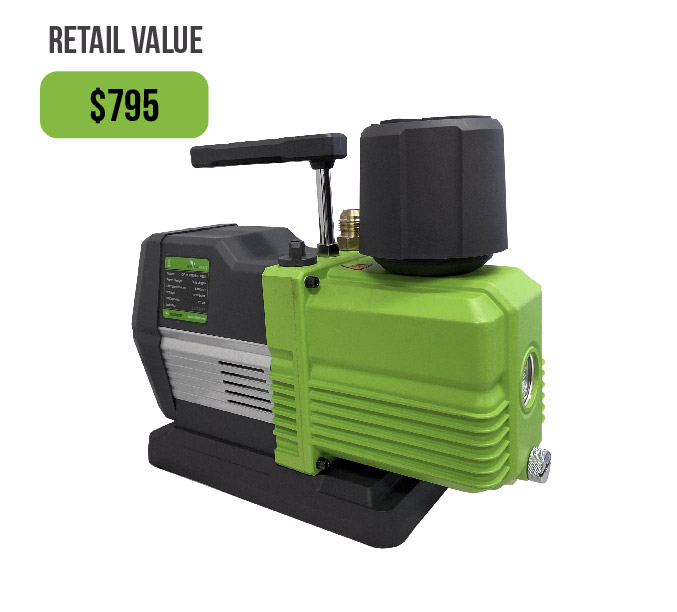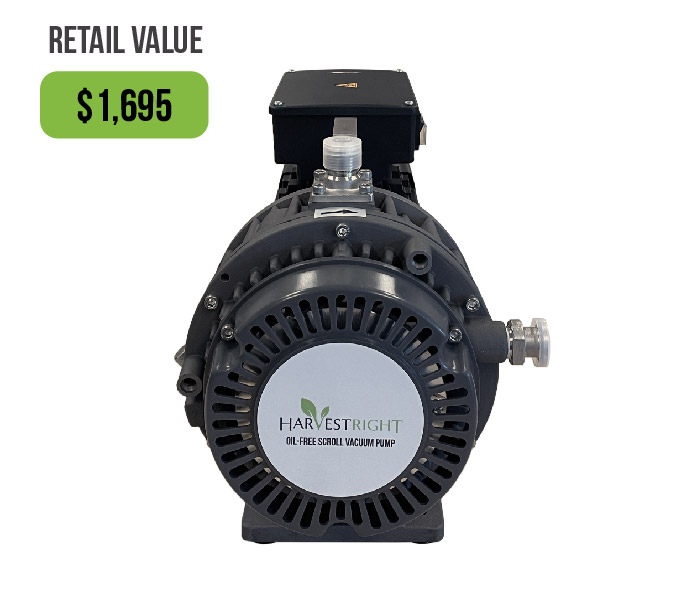Recently, the head engineer at Harvest Right wondered what would happen if he freeze-dried seeds. Would they germinate?
He freeze dried 10 different types of vegetable seeds, started them under grow lights inside his home, then transplanted them in a Garden Right geodesic dome greenhouse. It worked! Every single one of the seeds germinated – but you might be wondering what the practical applications would be. On a micro level, gardeners sometimes struggle to preserve heirloom seeds from one growing season to the next. If you don’t get your seeds absolutely dry or you don’t store them properly, they’ll mold and become unusable. On a macro level, it gets interesting.
There are thousands of seed banks around the world. They’re usually built in cold, remote places – like Svalbard. The problem is many of these cold, remote places are also politically or geologically unstable. Svalbard’s seed bank is a pretty safe bet. Even if the ice caps melt, the bank will be above sea level, there’s little chance of an earthquake, and it’s always frozen. Seeds can remain viable in the Svalbard seed bank for hundreds or thousands of years. So, in case there’s a major event and you need to grow some food from scratch, just put on your mittens and hike to Svalbard, right?
Or…you could just build your own seed bank. Granted we haven’t had 25 years to test our seeds to see if they’re still viable after a quarter of a century, but we have no reason to believe they wouldn’t be. With your own seed bank, you could establish or maintain a diverse garden for your family in case of emergency. Or, in case you just want to have your own, healthy, organic seeds. For example, a neighbor mentioned that she’d like to use her freeze dryer to preserve seeds from her flower garden for her granddaughters, who are still small. Imagine as an adult receiving heirloom seeds from your grandmother’s garden that were preserved while you were still a child. What a touching wedding, bridal or housewarming gift.
haven’t had 25 years to test our seeds to see if they’re still viable after a quarter of a century, but we have no reason to believe they wouldn’t be. With your own seed bank, you could establish or maintain a diverse garden for your family in case of emergency. Or, in case you just want to have your own, healthy, organic seeds. For example, a neighbor mentioned that she’d like to use her freeze dryer to preserve seeds from her flower garden for her granddaughters, who are still small. Imagine as an adult receiving heirloom seeds from your grandmother’s garden that were preserved while you were still a child. What a touching wedding, bridal or housewarming gift.
Freeze-dried seeds are easy to store, and easy to share and transport. They take up almost no room in the pantry. We recommend that you store them in Mylar bags with oxygen absorbers, just as you would your long-term freeze-dried foods. If you freeze dry seeds, let us know how it goes by sharing with the community on our Facebook page.





This is very interesting. How long were the seeds stored after freeze drying before they were reconstituted and used? I save seeds from the garden every year as well as purchasing seeds. If this process helps them last longer then the normal 2-5 year viability window it would be great to know. Anyone that does actual tests on this please post your details. Thanks
Seeds can/do last mu h longer than 5 years. The germination rate will decline but you will still have many grow. I have seeds that I’ve stored in temperatures controlled areas (a safe place inside) for close to 10 years and they still germinate at about 60%
I think this would have a good impact bug/pest wise. No chance of seeds bringing unknown parasites INSIDE!
how long were the freeze cycle and the dry cycle times -thanks
I want to know if the seeds were already dry before putting them in the freeze dryer or if they were pulled from the plant and immediately put into the freeze dryer. i will likely try both ways with my freeze dryer to test it out.
Thanks
The article said that the seeds need to be normalized first by standard drying techniques and then freeze-dried.
I would 100% rinse the seeds really well under warm water In strainer and air dried on paper towels and then dumped on trays to go in the freeze dryer
I just wanted to drop a link here for everyone to reference. Someone actually tried getting a patent to do this commercially in 1973, with instructions and results listed on this page. They successfully tried flash-freezing as well as putting the seeds directly in the freeze-dryer. Not necessarily a brand new technique, but still relatively new, and from this patent information, is shown to produce healthier seeds than traditional drying methods. https://www.google.com/patents/US3950892
Thank you!!!
And, you can have seeds that last 20-30 years!
Thank you for the link Becky! I read it and understood most of it at the “kinda-sorta” level. I think it said that the seeds need to be dried to the normally acceptable level of moisture before being freeze dried? I guess what I am trying to figure out is if I buy heirloom seed packets, and then freeze dried the seeds, when rehydrated thru planting, would they still be viable? Would it help to soak the seeds first or do I just need fresh seeds? Thanks to any and all that can enlighten me!
Hey Deb,
I am no expert but this is what the seed company told me at Fruition seeds: Drying seeds before any type of freezing Must be done or else the water/moisture content naturally found in the seed will freeze and the seed will be rendered unviable (dead). So Before freezing you would need to take your seed packets, open them up to the air and then place all of them in a gallon freezer bag standing upwards, then place a large desiccant pack from fruition seeds or enough oxygen absorbers inside the ziplock bag with them, expel the air inside the bag gently and leave that way for 3-4 Days to dry. Then you can carefully place them in the freezer for long term storage, or in this case, try to freeze dry them! 🙂 My FD is on order and I can’t wait to try this myself!!!
I don’t think using the Oxygen absorbers will have ANY EFFECT on seed moisture contend. Using a “refurbished” desiccant would do far more to remove moisture locked in the seeds. Also using a glass jar with a good fitting lid and loose seeds or seeds contained in a paper envelope (multiple different seeds could then be in the same jar at the same time) would be better than a plastic bag. The desiccant needs to be “good” in that if not maintained in a very air tight container until use, they will just absorb moisture. To refresh, the absorbers can be places in a 180/200 degree F oven for a reasonable period (1-3 hours) of time to drive off any moisture they have absorbed. Pill bottle and clothing (packaged in plastic) and other purchased items usually/often have desiccant packets within them and can be reused for this. If worried about fire, the packaging of the packets would be the first thing to melt or burn and the temperature to cause this would have to be a good deal hotter than recommended above. Commercially, seeds packaged for longer term storage are packaged in dense plastic (mylar and often aluminized mylar) bags that are flushed with Nitrogen before sealing. Any Oxygen in a sealed bag will allow the seeds to possibly sprout or more likely deteriorate (oxidize any oils or proteins),,, the Nitrogen stops this from occurring. Also darkness and cooler temps will help with longer seed viability, no matter what /how they are being stored.
You can even use some rice to pull moisture
I am very interested in the idea of freeze drying seeds. I had a giant pumpkin last year that weighed perhaps somewhere on the order of 600 pounds. While this is nowhere near the record for giant pumpkins (2,624.6 pounds in 2016). I wanted to dry my pumpkin seeds. I made a mistake of bagging them to soon and they molded. All ruined. So, this year I am going to freeze dry my giant pumpkin seeds. What would be most helpful for me is info/suggestion on technique. Should I dry them as best I can before freeze drying?. Or, should I simply take the seeds directly from the pumpkin to the freeze drier?. Any suggestions would be greatly appreciated. Thanks very much for any and all suggestions and comments.
Richard
Pumpkins make a LOT of seeds. Why don’t you try both methods?
Its been 2 yrs, how did things turn out?
I too am interested in how to freeze dry seeds. Thank u
This is all fascinating to me. And important. I would love to have a storage of freeze dried heirloom seeds.
Is there an update to this experiment? It was done 4 years ago. Were any of those seeds stored longer? And tried another year?
Any updates on this Harvest Right staff? (with regards to if the seeds need to be partially dried first before being freeze dried?) thanks!
still hoping for an update on this.. could you please post another blog about if the seeds are still viable?
Hi Gaven 5 years ago i freeze dried 10 different types of plants that where 15 gen old and this year for fun i started them in a areo garden . I had an 80% on all of them . I was really surprised . The way i save seeds is I take the ripest seeds and put them in a jar with water for a couple of days for bush plants i did nothing for the beens except dry them a room temp. and for vineing plants about a week skim of the floaters and stir them whats left at the bottom are good seeds then i dry them on screens at room temp. for about 4 weeks . Then I placed them in the freeze dryer just regular when it was finished ,i placed them in their own vacum sealed bags and stored them in a dry dark container nothing special
When you said “Then I placed them in the freeze dryer just regular when it was finished, I placed them in their own vacuum sealed bags and stored them in a dry dark container nothing special” what did you mean by “placed them in the freeze dryer just regular” you mean you didn’t change the settings? default settings were used? Did you use oxygen absorbers in the storage bags when you vacuum sealed them? Thanks for the information.
Seeds need a certain percentage of moisture content to remain viable. So I don’t see how freeze drying would preserve seeds for growing. (Horticulturist).
I would kike to know at what temperature the seeds were dried. I grow lots of my seeds, and this could be a total game changer for me.
I would like to know if you can freeze dry heirloom seeds you buy in the store too.
I believe I might have been the one who inspired Harvest Right to explore this question. I contacted them in 2021 to press this question, having purchased a large amount of sprouting seeds the germination viability time frame of which I was keen to extend, with hopes that freeze drying would solve the problem. It looks like it will be up to all of us to extend the experiment, please report back here with what you’ve learned, I will do the same!
The original article is from 2016. 🙂
Hi. Is there an update on this process? Thanks for your time in providing a response.
I see that it has been 6 years since you posted about your first test. Have you tried planting some of the seeds every year to see if the germination rate is staying fairly consistent? It would be interesting to know how much they degrade over time. Even though there has not been time to see if they last 25 years, 6 years worth of data is better than none.
What is Harvest Right’s suggested settings for seeds. Are they different for different seeds? I see that several people have asked for updates…is there any follow up on this topic? Now is the time to freeze dry seeds.
What are the recommend settings for freeze drying seeds for long term storage and to use for planting?
Does the freeze drying process raise the temperature above 50 degrees F? If so, doesn’t that begin to kill the seeds? With time, temperature and light, increasing all these would degrade the live seed. Right?
This is a great point! The freeze drying temperature can be adjust so that if needed the trays won’t get about 50 degrees F. Typically customers will pack the seeds in a mylar bag to make sure light doesn’t get to the seed.